We were lulled to sleep last night by the rhythmic pounding of the huge Atlantic waves breaking onto the beach on the far side of the dunes sheltering us from the force of the wind. During the night the rain hammered relentlessly on Modestine’s roof and there were several rolls of thunder.
This morning it continued much the same and throughout the day the weather has led us a dance – snow, snow, sleet, sleet, snow! Rain and hail actually with long bright periods in between but lots of thunder and lightning. We are still carrying around a bag of wet laundry from Coimbra with no possibility of drying it and meanwhile the rest of our clothes are getting soaked.
The campsite at Viana do Castelo stands on the opposite side of the estuary of the River Lima from the main town. The two parts are linked by an iron bridge designed by Gustave Eiffel and we were curious to see this. However, the bridge is closed to traffic for essential repairs and the only way across to the town is via a massive diversion inland. As we were parking Modestine safely on the edge of town a very curious and smiling man came to peer enthusiastically through her windows. He was delighted when we offered to show him inside and chatted away happily in Portuguese. Somehow we seemed to understand each other. He wanted to know if it would sleep three people, how much we paid for her in Euros, did we want to sell her, the problems of right hand drive, gosh, we even had a fridge etc. Then he explained the best parts of the town to visit and sights not to be missed. He then gesticulated towards a bus parked slightly further down the road full of patient passengers and explained that he had to go as he was the driver but had stopped to look at Modestine! His directions for visiting the town were very good. It turned out to be a wonderful little place and we were delighted to realise we had actually understood most of what he’s told us.
Viana do Castelo really is a little gem of a town which until yesterday we’d never heard of. It has a population of around 20,000 and its historic centre is constructed mainly in granite. The main square, the Praça da República, has a beautiful sixteenth century fountain and several handsome buildings with decorated granite lintels, rounded arches and decorative windows. Indeed, the entire town is a mass of wonderfully ornate civic buildings, convents, churches and houses dating from the 16th and 17th centuries, each as stunning as the next.
 Praça da República, Viana do Castelo
Praça da República, Viana do Castelo Casa da Câmara, Viana do Castelo
Casa da Câmara, Viana do Castelo Houses with balconies Praça da República, Viana do Castelo
Houses with balconies Praça da República, Viana do Castelo Typical building with Manueline decoration, Viana do Castelo
Typical building with Manueline decoration, Viana do CasteloDown by the port on the mouth of the river there are the grim granite remains of the old castle, still very much intact, overlooking the sea. Inside its defensive wall is a picturesque 19th century lighthouse.
 Lighthouse inside the fort, Viana do Castelo
Lighthouse inside the fort, Viana do CasteloThere are well laid-out formal gardens and a bandstand along the seafront and beautiful sandy beaches and dunes, whilst inland the church of Santa Luzia stands on a hillside offering spectacular views across the entire town, the surrounding landscape and the sea. When not closed for repairs Eiffel’s two-level bridge of crossed iron girders would give a nineteenth century grandeur to the riverside.
 Formal gardens, the marina and Gustave Eiffel’s bridge, Viana do Castelo
Formal gardens, the marina and Gustave Eiffel’s bridge, Viana do Castelo Santa Luzia on the hillside above the town of Viana do Castelo
Santa Luzia on the hillside above the town of Viana do Castelo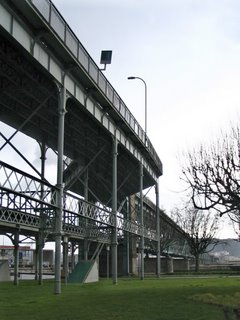 Gustave Eiffel’s two-level bridge, Viana do Castelo
Gustave Eiffel’s two-level bridge, Viana do CasteloThere is of course another dimension to the town. It has a very happy atmosphere and people seemed to have time to chat. The streets are full of interesting little shops – lots of hardware stores, butchers and general grocers. There are very many restaurants and cafés – known as pastelarias. All have customers. The Portuguese seem to spend a great deal of time in cafés. We joined some of them in a bakers-cum-pastelaria for a couple of coffees and sticky cakes. Pleasant waitress service, allowed to choose our cakes from behind the counter as we didn’t know how to ask for them, and a bill of less than three euros – about £2!
Having almost recovered from our recent ecclesiastical surfeit in Coimbra, we visited several more churches today including the granite-built early 16th century cathedral with its flamboyant gold baroque reredos and far prettier side chapels and painted trompe l’oeil arcading.
 Cathedral, Viana do Castelo
Cathedral, Viana do Castelo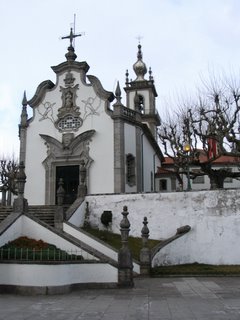 Senhora d’Agonia, Viana do Castelo
Senhora d’Agonia, Viana do CasteloDespite the cakes we were soon hungry again. Several restaurants had menus advertising a special treat of lampreys. We really ought to have tried them but opted instead for a tiny café where we had the dish of the day – an enormous plateful of meat and vegetable stew for 4 euros (£2.80) each! After that, we made our way rather slowly back to Modestine, vowing never to eat so much at lunchtime again! On the way we paused to admire the skill with which the roads of granite cobbles are repaired, each stone being embedded into the soft sand which underlies the town.
 A load of cobblers, Viana do Castelo
A load of cobblers, Viana do CasteloFollowing the coast road we soon found ourselves at Caminha where we knew there was a campsite open. This, like last night’s site, is part of a chain of campsites. There is nothing actually wrong with them but they are all rather boring and the same. We tend to forget which site we are on and set off in the wrong direction for the showers – oh no, that was yesterday! We are finding that although we are moving around Portugal, because the campsites and Modestine are pretty well identical wherever we are, we have the impression that we are stationary and Portugal is moving around us! This site is on the estuary of the river Minho. It is situated amongst pine and eucalyptus trees, just back from the sea where sand dunes protect us from the pounding of the huge Atlantic waves breaking onto the beach. Does all this sound rather familiar? As we move north there are fewer tourists and camping cars. Indeed, tonight we are the only people on the site! But because we are here, there has to be a security guard all night and the lights in the shower block have to be left on. For our ten euros a night it cannot possibly make economic sense! Still, we do get the benefit of it all.
On the far side of the river is Spain. Tonight we had a power cut for a couple of hours. As we shivered without our fan heater in Modestine and the entire campsite and the Portuguese town of Caminha were plunged into pitch darkness, across the river we could see the blaze of lights from the streets and houses of Spain!
 Approaching storm and sand dunes, Caminha
Approaching storm and sand dunes, Caminha View across to Spain, Caminha
View across to Spain, Caminha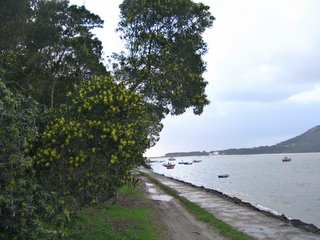 Mimosa beside the River Minho, Caminha
Mimosa beside the River Minho, CaminhaTuesday 21st February 2006, Santiago de Compostela, Spain
“All the way, to Santiago.” As we drove north through Portugal from Caminha and across into Spain we found ourselves humming repetitively these lines from Devon’s very own folk group, Show of Hands. Work colleagues introduced us to their music when they gave a concert at Exeter’s Northcote Theatre in 2004 and today this song has revolved continuously around in our heads.
Today the weather has been much brighter but freezing cold. We are amazed at the difference in temperature a few hundred miles further north can make! A week ago we were walking the cliff tops in tee shirts and sitting in the moonlight on our computer at 10pm. Today it has been woolly jumpers and windproof jackets. Even our gloves have been re-excavated and tonight we will definitely need that extra sleeping bag we shivered without last night!
After phoning Kate – it is her birthday today, we spent this morning exploring Caminha, a really delightful little granite town of a couple of thousand inhabitants on the river Minho from where, throughout the day, a small ferry takes local traffic across the river to and from Spain.
Caminha is exactly what we have been seeking in Portugal. It is completely unspoilt by tourism and delightfully picturesque, existing solely for its inhabitants. Surrounded by defensive granite walls it has pleasant gardens with colourful flowerbeds along beside the river. There is virtually no traffic within the walls, the cobbled granite streets being too narrow to accommodate vehicles. The town has no more than four or five main streets and each is full of handsome buildings with decorated carved granite facades, mullioned windows and ornate doorways. The cobbled central square has an ornate fountain and is surrounded on all sides by 17th century stone faced buildings providing shops, businesses and little cafés. At the top of one of the side streets we found the convent of St. Anthony and the town cemetery with its imposing granite tombs. Around the edge were family mausoleums in decorated granite like streets of houses, each with its own tombs and individual altar. From here we had excellent views across the river to Spain and to the surrounding hills.
 Central square, Caminha
Central square, Caminha Town cemetery, Caminha
Town cemetery, CaminhaDown in the town we visited the Igreja da Misericórdia. Attractively decorated in granite on the exterior, within it was an exuberant celebration of extravagant baroque! In such a tiny town we were astonished to see such an ornate and elaborate church which equalled, excelled even, anything we had seen in Evora or Coimbra.
 Altar of the Igreja da Misericórdia, Caminha
Altar of the Igreja da Misericórdia, Caminha Detail of Baroque carving, Igreja da Misericórdia, Caminha
Detail of Baroque carving, Igreja da Misericórdia, CaminhaThe great joy of a town this size is that, unlike Coimbra, it is so easily manageable for sight-seeing. Everything is close together, there is no traffic and it is easy to admire the splendours of its architecture, history and culture side by side with seeing the everyday life of a small Portuguese town. One of today’s delights was watching the local nursery school being taken on an outing across town. Some twenty four-year- olds held hands in a long, babbling crocodile, lead by their teachers. Suddenly everything came to a halt as one of the children recognised granddad outside the pasteleria and broke ranks for a quick hug. She then returned to her place, rejoined hands and the crocodile continued up the main street. It was such a delightful incident, showing us a further dimension to this charming little town.
 Nursery school outing, Caminha
Nursery school outing, CaminhaBecause of the use of granite, the size of the buildings and the nature of the landscape – many river inlets, rias and long sandy beaches – we were reminded very much of Fisterre in Brittany. This last little town we visited in Portugal was actually one of the nicest and we would welcome the chance to return here one day.
 Statue to local fishermen, Caminha
Statue to local fishermen, CaminhaThe roads in Portugal pass through the centre of every town and are heavily used by huge container lorries avoiding tolls on the motorway. This means road surfaces have subsided, they are potholed with cracked and broken tarmac and are very unpleasant to use for long distances. Having experienced some of the worst surfaced roads anywhere in Europe as we headed north, we decided to take the motorway from Valença, on the border between Portugal and Spain, up to Santiago. This was so much easier with dual carriageways and fast smooth surfaces which gave the opportunity to admire the wonderful scenery of hills and high viaducts across countless estuaries and rias, rather than concentrating on avoiding waterlogged ruts and craters in the road. It was well worth the toll charge of seven euros.
So we reached Santiago around 5pm. It seems to be huge! Somehow we had expected it to be something like Lourdes in scale but it has a population of well over 100,000 with a large commercial and business centre through which we had to pass before finding the ring road around the city to the only campsite. Sites down in the south of Spain were absolutely packed out, but further north in the cold we are the only visitors. As at Lourdes, pilgrimages seem confined to the summer months.
Wednesday 22nd February 2006, Santiago de Compostela, Galicia, Spain
Jill thought she was already suffering from an excess of Christian churches, marble tombs, carved saints, crosses and religious artefacts before we even reached Santiago! She soon discovered all that was no more than an hors d’oeuvre to today’s main course!
We woke to find the campsite covered in a fine film of white frost and the temperature in the shower block somewhere around zero. Fortunately there was plenty of hot water but the Spanish predilection for marble tiling isn’t inductive to early morning showering.
Leaving Modestine all alone on the campsite high above the town we took the bus down to the historic quarter around the Cathedral. Santiago seems built entirely from granite in a variety of colours and textures. Because it weathers so much better than sandstone, church carvings and exterior decorations of major buildings are clearly defined, as sharp as when originally done.
Our first impression of the granite flagged square, the Praza do Obradoiro, in front of the Cathedral was of stunned awe! It is truly huge, its granite spires licking up to the heavens like towering columns of flame. Around the square were a few pilgrims, complete with rucksacks and bibles, standing alone and praying before mounting the flights of steps to the Cathedral with its quota of pathetic beggars seeking alms at the door. The main entrance is a later addition giving the appearance of a Baroque building. Once inside though, it is basically Romanesque with heavy, later, Baroque decoration.
 Cathedral, Compostela
Cathedral, CompostelaFirst one is greeted by a huge screen of carved granite by Maestro Mateo depicting St. James surmounted by a frieze of musicians. This is stunning and depicts very clearly, not only the instruments that were used in the late12th century, but how they were played! There is a socket into which pilgrims traditionally press their hand to signify their arrival and the end of their journey. There is also a rather worn statue known as the saint of bumps. Banging your head against him is said to improve your memory and bring wisdom. We thought both rather doubtful but Ian had a go in the hope he’d start remembering where he’d put things in Modestine!
 St. James at the entrance to the Cathedral, Compostela
St. James at the entrance to the Cathedral, CompostelaMuch of the rest of the day was spent in the cathedral. It is so huge that it is no exaggeration to say one can easily get lost in there! There are priests sitting in confessionals along the sides and a mass is always under way somewhere in the cathedral, making it possible for pilgrims to receive communion at any time.
The stone carvings around the capitals of columns, across lintels and around tombs were all very skilfully executed and delightful to see, depicting as they generally did, scenes from everyday life, the bible or mythical figures such as the pelican tearing at her breast to provide blood to feed her young chicks.
 Carved pelican, Compostela
Carved pelican, CompostelaThe main altar was a riot of heavy Baroque gold lacquered carving, with cherubs, fruits, flowers, saints, martyrs and crucifixions. It was possible to climb up behind the main altar to kiss the mantel of the 13th century statue of St. James which dominates the altar. Beneath the choir is the crypt where the large gold and silver reliquary in which the remains of St. James are held.
 Reliquary of St. James, Compostela
Reliquary of St. James, CompostelaNeeding to get our heads round it all we nipped across the square to the local hostel for some refreshment and a quick read through our Michelin guide book. This was not quite your average hostel though. The Hostel of the Catholic Monarchs was built in the 16th century by Ferdinand and Isabella to house pilgrims. To quote M. Michelin – “it has a splendid Plateresque doorway.” We’d agree with that. Today the building is used as a Parador for pilgrims with a large bank balance. Having learned the technique of getting past doormen in Paradors, we wandered in past reception and headed for the bar, treading our way along thick piled rugs, past brocade covered sofas and huge dark wood tables with vases of fresh flowers, frowned down upon by large, gold framed portraits of Spanish monarchs. In the bar we ordered hot chocolate and croissants from the red jacketed, white gloved waiter and surrendered ourselves temporarily to a religion-free zone. This is as much as we are ever likely to experience of these magnificent state run Spanish hotels but it’s probably enough. This experience of luxury cost us a mere 8.50 euros (about £6). Afterwards we wandered around exploring the different lounges and the chapel. Nobody seemed to mind and the doorman actually held the door open for us as we left to return to the Compostela Experience.
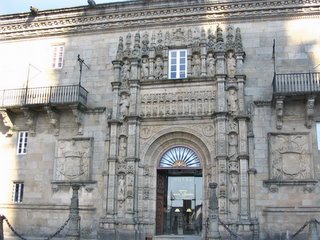 Hostel of the Catholic Monarchs, Compostela
Hostel of the Catholic Monarchs, CompostelaThe rest of the morning was spent exploring the Cathedral museum with its chapel containing the remains of several of the Spanish monarchs. We also visited the late gothic cloisters and the 18th century library which houses the botafumeiro – a giant censer (incense burner) which requires eight men to swing it when suspended from the roof at grand celebrations in the Cathedral. The museum also includes the mid-18th century chapter room and an excellent exhibition of tapestries based on drawings by Rubens, Teniers and Goya. Teniers depicted pastoral life, a pleasant change from the heavy religious or classical subjects of so many tapestries, while the Goya works, produced in the 1770s, were much lighter in mood than his later Disasters of war etchings we had seen in Castres last November.
 Cathedral cloisters, Compostela
Cathedral cloisters, Compostela Cathedral library with the botafumeiro, Compostela
Cathedral library with the botafumeiro, CompostelaTime for lunch and an hour or more back in the real everyday world. We found a nice little café where the waitress spoke English – no need to struggle to disentangle pidgin Spanish from pidgin Portuguese – with an “eat until you pop” menu of paella and salad with bottled beer followed by carrot cake and coffee. More expensive than Portugal but still good value at 16 euros for two.
Finally we returned to the Cathedral for a scramble around the icy cold Palacio Gelmírez, a Romanesque bishop’s palace built in the 12th century. This too was entirely constructed in granite with a large ceremonial room of superbly carved columns depicting scenes from the wedding banquet of Alfonso IX, king of Leon. Throughout the day the weather has been bitterly cold with a couple of minor showers of hail. As it is impossible to heat something the size of the cathedral and its many precincts with their marble tombs and dank granite walls we were very chilled by the time we finally left and made our way back into the town.
 Ceremonial hall in the Palacio Gelmírez, Compostela
Ceremonial hall in the Palacio Gelmírez, Compostela Disco at Alfonso’s wedding, Compostela
Disco at Alfonso’s wedding, CompostelaPassing a fish restaurant we stopped to examine the menu displayed in the window as it waved its various tentacles and pincers at us. We are now glad that unlike King John, we did not surfeit on lampreys yesterday. They are huge long eels with horrible suckers for mouths and spots down the side which we take to be a primitive form of gills. On the shelf above them were real live coquilles Saint Jacques and a plate of something really awful that looked like a dentists collecting dish after a particularly busy day. Does anyone know what they are other than the stuff of nightmares? Ian suggests barnacles.
 Coquilles Saint Jacques and the devil’s dentures! Compostela
Coquilles Saint Jacques and the devil’s dentures! CompostelaWe passed the Renaissance façade of the Colegio de Fonseca, named after the archbishop who ordered its construction in the 16th century. Glancing at the magnificent cloisters we noticed that an exhibition was advertised. This proved to be free and WARM and about Jesús Bal y Gay (1905-93) a leading Spanish musician, a friend of Falla and of other noted composers. Before leaving Spain for France, Cambridge and Mexico in the 1930s – part of Franco’s brain-drain – he had done for Galician folksong between 1928 and 1934 much the same as Devon’s Baring-Gould had done for the Songs of the West in the late 1880s. On display was his massive card file, each card with a manuscript note of a traditional melody he had collected, classified by genre. It was not until his return to Spain in the 1970s that Cancionero gallego was published in two volumes, one with the melodies and the other with the texts and historical notes.
 Colegio de Fonseca, Compostela
Colegio de Fonseca, CompostelaWe spent longer than intended in the exhibition and emerged to find the evening chill and darkness descending, the streets crowded with people leaving work. We joined them on their homeward bus journey.
Friday 24th February 2006, Candas, Asturias, Spain
Last night we were horribly betrayed by our guidebook to European camp sites. It has already proved inaccurate on a number of occasions in Spain but this time it really let us down leaving us with no alternative but the beach to pass a cold winter’s night! So we were unable to write up the very pleasant events of yesterday until this evening.
We woke yesterday to a really thick frost. Temperatures overnight were way below zero and we were very grateful for our little fan heater. Now we are in the north of Spain we rarely see another camping car, campsites are very few and far between and we are usually the only people using them.
We left Santiago around 9am and headed off to Spain’s far west point, Cabo Fisterre. Having visited all the other far corners of Spain and Portugal this was not to be missed. Soon we had left the city behind and were driving along pleasant country roads through green fields with dry stone walls. The coastal scenery was stunningly beautiful and once the sun melted the frost the day turned out to be warm and bright, perfect for enjoying such a truly beautiful land and seascape as offered by this furthest, most isolated tip of rural Spain. Here, in contrast to Southern Spain and Portugal, sandstone has given way to granite and yellow mimosa has been replaced by equally bright yellow gorse. Eucalyptus trees and pines however, are as apparent here as further south.
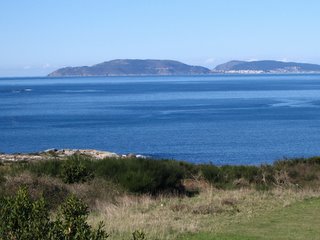 Cabo Fisterre seen from 15 kilometres away across the bay at Lira
Cabo Fisterre seen from 15 kilometres away across the bay at LiraOur route wound around the different headlands and back between the many rias and estuaries, passing through peaceful little granite-built fishing villages and ports. As we moved further into rural Galicia there were countless little buildings constructed from granite slabs raised up on columns. These are common to Galicia , and in a different style, to Asturias as well. Known as horreos they are used for storing and drying grain safe from rats and mice. Most are small and individually owned but in Carnota we saw a huge, long, granite built horreo used by the entire village. This one had been built in two stages between 1760 and 1783 in competition with the neighbouring parish of Lira which has a similar horreo or granary. This unlikely local rivalry had resulted in the two longest horreos in the whole of Galicia. Nearby we found the village cemetery where the dead are piled high above ground rather than buried below.
 Horreo or granary, Carnota, Galicia
Horreo or granary, Carnota, Galicia  Necropolis – filing cabinets for the departed! Carnota, Galicia
Necropolis – filing cabinets for the departed! Carnota, Galicia As we mentioned when we were in Portugal, there is something incredibly similar about these final tips of land, be they Spain, Portugal, France, England or Wales. Here at Spain’s Fisterre we could just as easily have been at Land’s End, or in Brittany. Though building styles are different, the way people live in these landscapes seems so similar, their lives so closely linked with the sea. On the Cabo de Fisterre there is a cross to mark the lives of those lost along this treacherous stretch of coastline, known with good reason as Costa de la Muerte (Coast of Death).
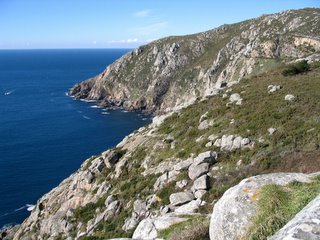 Land’s End – but Cornwall, Brittany or Galicia?
Land’s End – but Cornwall, Brittany or Galicia?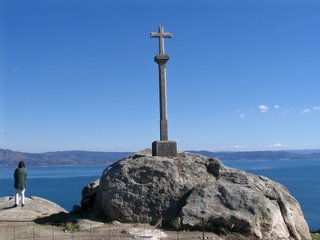 Cross to those lost along the Costa de la Muerte, Galicia
Cross to those lost along the Costa de la Muerte, GaliciaHaving walked up to the lighthouse on the furthest possible tip of Fisterre, we sat soaking in its peaceful charm in the warm afternoon sunshine, gazing out to the bright blue horizon and along the rocky headland across on the far side of the ria.
 The lighthouse, Fisterre, Galicia
The lighthouse, Fisterre, GaliciaReluctantly we realised we would need to move on to find anywhere to stay for the night. Away from the migration route south, there are very few campsites open at this time of year and the nearest one listed on our gradual route back to France was some 200 kilometres away at Reinante!
Well, we thought, we can always find an hotel if we don’t get there before dark. We made excellent progress however and realised we might just make it. Darkness fell as we turned off down little lanes between dry stone walls, exactly like Cornwall’s far west, down to the deserted sandy beach, to discover the campsite was shut! Furthermore, there was nothing else around except a few cottages and most of the little roads were just rough tracks, unsuitable to explore in Modestine in the dark! No hotels or guest houses anywhere.
So there was no option but to shut ourselves in Modestine with the gas cooker for warmth, close the blinds and open the wine. We actually spent a very peaceful night and slept well, as the rain started again, hammering on the roof. Mercifully it was a lot warmer than the previous night and we were not too cold. We woke to a view of the sea between the dunes with little fishing boats already out tending their nets.
We moved on fairly promptly. We were cold and damp and had no wish to draw attention to the fact that we’d been sleeping in the village street even though we’d had no option. Each day we say we’ve had enough of this cold and wet – we cannot remember the last time there was a whole day without rain – and that we will find an hotel or pension for a treat. However, they are really for emergencies, when we cannot find a campsite and anyway, in the rural places we now find ourselves, even the hotels seem closed.
This morning we turned off the main route to Oviedo down to the sea to discover the little fishing port of Puerto de Vega. Chance took us there but we spent a really enjoyable few hours. There is nothing remarkable or picturesque about the little town, but it is full of life, largely unchanged for generations. It appears to have been a whaling town since the 17th century, and formerly had its own fish canning factory providing employment to the women of the town. Today life is centred round the harbour and fishing still provides the chief employment.
We went into a quayside bar for a couple of coffees and desayuno. Too late for breakfast, so we contented ourselves with the coffee and looked at the only thing on display that was edible – a very large tank of active crabs of assorted sizes! The menu appeared to offer nothing but clams, prawns, lobster or fish. Oh yes, and scrambled eggs – with clams, prawns, lobster or fish! There were about a dozen elderly local men, probably retired fishermen, in wellies and flat hats. None were buying anything, just standing at the bar chatting and laughing – one had no teeth, all were brown and wrinkled. They eyed us curiously but then ignored us.
Back outside the wind was icy and the rain falling again. Having explored the harbour with its harpoon gun, we discovered the public library. Inside we were impressed at the size of its local history collections with multivolume encyclopedias, histories and atlases of Asturias and photographic records of village life and the fishing industry along this northern seaboard of Spain. It is clear from the literature on the shelves that there is a much stronger feeling of regional identity in Spain than in England. Ian found the classification scheme odd and we ended up having a complicated chat with the librarian in a mixture of English and Spanish. He assured us all Spanish libraries arranged their stock on the shelves from the bottom to the top rather than top to bottom and went to some lengths to explain how classmarks were assigned. (We’ve since checked out what he told us and we think he’s wrong. Other Spanish libraries arrange their materials as we do in England.)
 Harpoon gun use for whaling, Puerto de Vega, Asturias
Harpoon gun use for whaling, Puerto de Vega, Asturias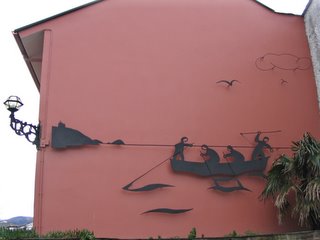 Ironwork mural, Puerto de Vega, Asturias
Ironwork mural, Puerto de Vega, Asturias Ironwork mural, Puerto de Vega, Asturias
Ironwork mural, Puerto de Vega, AsturiasBy this time the museum next door had opened for a couple of hours. We were the only visitors today and the curator did not speak English but was friendly and helpful. The museum had formerly been the local canning factory and the original ovens and canning equipment were still in the yard outside. Exhibits included all local crafts from carpenter, sail-maker, blacksmith, shoemaker, fisherman and patten-maker (wooden clogs which we actually saw being worn in the village today!) It was a fascinating collection covering every aspect of the local life of the town over the past couple of hundred years. There were matchstick models of the main buildings and tiny scale models of old sailing ships as well as collections of shells and plants. Even the old projector from the local cinema was on display along with ship’s compasses and other navigational aids.
 Local museum, Puerto de Vega, Asturias
Local museum, Puerto de Vega, Asturias Model of the Mayflower, Puerto de Vega, Asturias
Model of the Mayflower, Puerto de Vega, AsturiasThe rain was still falling so we followed a trickle of people accompanied by children in fancy costume who seemed to converge on a little café opposite the town’s administrative building. Why the children were dressed as fairies, rabbits and pirates we never discovered but the café turned out to sell really nice pinchos (snacks) and beer. By now we were starving hungry so did full justice to the plateful provided before leaving Puerto de Vega and continuing towards Candas where we hoped to find a campsite.
We reached here around 3.30 and having assured ourselves the site existed and was indeed open, we went into the local town, another seaside fishing port. It seems pleasant with a peaceful little harbour. There appear to be buses and trains to Oviedo and Gijon, neither far from here but not nice to visit by car. Tomorrow, in the hope that the rain will eventually stop, we will explore public transport possibilities further.
 View from Modestine’s window on our campsite, Candas, Asturias
View from Modestine’s window on our campsite, Candas, Asturias